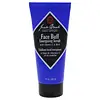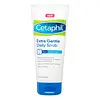What's inside
What's inside
 Key Ingredients
Key Ingredients

 Benefits
Benefits

 Concerns
Concerns

 Ingredients Side-by-side
Ingredients Side-by-side

Water
Skin ConditioningPolyethylene
AbrasiveGlyceryl Stearate
EmollientDisodium Cocoamphodiacetate
CleansingHexylene Glycol
EmulsifyingSodium C14-16 Olefin Sulfonate
CleansingCetyl Alcohol
EmollientCeteth-2
EmulsifyingMenthyl PCA
HumectantCalendula Officinalis Extract
Skin ConditioningDipotassium Glycyrrhizate
HumectantAllantoin
Skin ConditioningAscorbic Acid
AntioxidantMenthol
MaskingCaprylic/Capric Triglyceride
MaskingSodium Acrylate/Sodium Acryloyldimethyl Taurate Copolymer
Emulsion StabilisingMagnesium Aluminum Silicate
AbsorbentIsohexadecane
EmollientPolysorbate 80
EmulsifyingPropylene Glycol
HumectantCaprylyl Glycol
EmollientParfum
MaskingPhenoxyethanol
PreservativeChlorphenesin
AntimicrobialWater, Polyethylene, Glyceryl Stearate, Disodium Cocoamphodiacetate, Hexylene Glycol, Sodium C14-16 Olefin Sulfonate, Cetyl Alcohol, Ceteth-2, Menthyl PCA, Calendula Officinalis Extract, Dipotassium Glycyrrhizate, Allantoin, Ascorbic Acid, Menthol, Caprylic/Capric Triglyceride, Sodium Acrylate/Sodium Acryloyldimethyl Taurate Copolymer, Magnesium Aluminum Silicate, Isohexadecane, Polysorbate 80, Propylene Glycol, Caprylyl Glycol, Parfum, Phenoxyethanol, Chlorphenesin
Water
Skin ConditioningCocamidopropyl Betaine
CleansingDisodium Cocoamphodiacetate
CleansingCoco-Glucoside
CleansingSodium Cocoamphoacetate
CleansingGlycerin
HumectantPanthenol
Skin ConditioningTocopheryl Acetate
AntioxidantBambusa Arundinacea Stem Extract
Skin ConditioningSodium Hydroxide
BufferingSodium Benzoate
MaskingSodium Citrate
BufferingXanthan Gum
EmulsifyingHeliotropine
MaskingPhenoxyethanol
PreservativePolyquaternium-10
Acrylates/C10-30 Alkyl Acrylate Crosspolymer
Emulsion StabilisingCitric Acid
BufferingParfum
MaskingWater, Cocamidopropyl Betaine, Disodium Cocoamphodiacetate, Coco-Glucoside, Sodium Cocoamphoacetate, Glycerin, Panthenol, Tocopheryl Acetate, Bambusa Arundinacea Stem Extract, Sodium Hydroxide, Sodium Benzoate, Sodium Citrate, Xanthan Gum, Heliotropine, Phenoxyethanol, Polyquaternium-10, Acrylates/C10-30 Alkyl Acrylate Crosspolymer, Citric Acid, Parfum
Ingredients Explained
These ingredients are found in both products.
Ingredients higher up in an ingredient list are typically present in a larger amount.
Disodium Cocoamphodiacetate is a surfactant and helps cleanse skin. It is created from the fatty acids of coconut oil.
Surfactants help rinse oil, dirt, and other pollutants easily from skin. It has a faint fruit-like scent.
Parfum is a catch-all term for an ingredient or more that is used to give a scent to products.
Also called "fragrance", this ingredient can be a blend of hundreds of chemicals or plant oils. This means every product with "fragrance" or "parfum" in the ingredients list is a different mixture.
For instance, Habanolide is a proprietary trade name for a specific aroma chemical. When used as a fragrance ingredient in cosmetics, most aroma chemicals fall under the broad labeling category of “FRAGRANCE” or “PARFUM” according to EU and US regulations.
The term 'parfum' or 'fragrance' is not regulated in many countries. In many cases, it is up to the brand to define this term.
For instance, many brands choose to label themselves as "fragrance-free" because they are not using synthetic fragrances. However, their products may still contain ingredients such as essential oils that are considered a fragrance by INCI standards.
One example is Calendula flower extract. Calendula is an essential oil that still imparts a scent or 'fragrance'.
Depending on the blend, the ingredients in the mixture can cause allergies and sensitivities on the skin. Some ingredients that are known EU allergens include linalool and citronellol.
Parfum can also be used to mask or cover an unpleasant scent.
The bottom line is: not all fragrances/parfum/ingredients are created equally. If you are worried about fragrances, we recommend taking a closer look at an ingredient. And of course, we always recommend speaking with a professional.
Learn more about ParfumPhenoxyethanol is a preservative that has germicide, antimicrobial, and aromatic properties. Studies show that phenoxyethanol can prevent microbial growth. By itself, it has a scent that is similar to that of a rose.
It's often used in formulations along with Caprylyl Glycol to preserve the shelf life of products.
Water. It's the most common cosmetic ingredient of all. You'll usually see it at the top of ingredient lists, meaning that it makes up the largest part of the product.
So why is it so popular? Water most often acts as a solvent - this means that it helps dissolve other ingredients into the formulation.
You'll also recognize water as that liquid we all need to stay alive. If you see this, drink a glass of water. Stay hydrated!
Learn more about Water